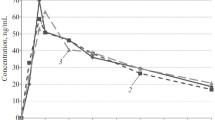Summary
Eight healthy men received an oral dose of 0.25 mg/kg diazepam followed 40 min later by an intravenous infusion of 100 ml physiological sodium chloride solution, with or without 4.4 mg/kg theophylline. Psychomotor function was assessed after each blood sampling up to 5 h post-infusion.
Thirty min after diazepam psychomotor performance measured by Card Sorting test and Digit Symbol Substitution test was impaired and subjects felt sleepy and could think less clearly (two factors of the Clyde Mood Scale). Theophylline antagonized the diazepam-induced impairment statistically significantly for up to 5 h and subjects felt less tense and less apprehensive (State Anxiety Inventory). Since pharmacokinetic parameters of diazepam seemed not to be different after theophylline, interaction at receptor level can be assumed.
Similar content being viewed by others
References
Berry C, Gelder MG, Summerfield A (1965) Experimental analysis of drug effects on human performance using information theory concepts. Brit J Psychol 56: 255–265
Clyde DJ (1963) Manual for the Clyde Mood Scale. Clyde Computing Service, Miami, Fla, USA
Costa E, Guidotti A (1979) Molecular mechanisms in the receptor action of benzodiazepines. Ann Rev Pharmacol Toxicol 19: 531–545
Derogatis LR, Lipman RS, Covi L (1973) SCL-90: An outpatient psychiatric rating scale — preliminary report. Psychopharmacol Bull 9: 13–26
Ferguson JL, Couri D (1977) Electron capture gas chromatography determination of benzodiazepines and metabolites. J Analyt Toxicol 1: 171–174
File SE, Bond AJ, Lister RG (1982) Interaction between effects of caffeine and lorazepam in performance tests and self-ratings. J Clin Psychopharmacol 2: 102–106
Fredholm BB (1980) Are methylxanthine effects due to antagonism of endogenous adenosine? Trends Pharmacol Sci 1: 129–132
Hills M, Armitage P (1979) The two-period cross-over clinical trial. Br J Clin Pharmacol 8: 7–20
Hindmarch I (1980) Psychomotor function and psychoactive drugs. Br J Clin Pharmacol 10: 189–209
Hollister LE, Gillespie HK, Richards RK (1968) Comparison of tetrahydrocannabinol and synhexyl in man. Clin Pharmacol Ther 9: 783–791
Lipman RS, Covi L, Shapiro AK (1979) The Hopkins symptoms checklist (HSCL). Factors derived from the HSCL-90. J Affect Dis 1: 9–24
Marangos PJ, Paul SM, Parma AM, Goodwin FK, Syapin P, Skolnick P (1979) Purinergic inhibition of diazepam binding to rat brain (in vitro). Life Sci 24: 851–858
Phillis JW, Wu PH (1980) Interactions between the benzodiazepines, methylxanthines, and adenosine. Can J Neurol Sci 7: 247–249
Phillis JW, Wu PH (1981) The role of adenosine and its nucleotides in central synaptic transmission. Prog Neurobiol 16: 187–239
Phillis JW, Edstrom JP, Ellis SW, Kirkpatrick JR (1979) Theophylline antagonizes flurazepam-induced depression of cerebral cortical neurons. Can J Physiol Pharmacol 57: 917–920
Phillis JW, Siemens RK, Wu PH (1980) Effects of diazepam on adenosine and acetylcholine release from rat cerebral cortex: Further evidence for a purinergic mechanism in action of diazepam. Br J Pharmacol 70: 341–348
Polc P, Bonetti EP, Pierce L, et al (1981) Caffeine antagonizes several central effects of diazepam. Life Sci 28: 2265–2275
Skolnick P, Marangos PI, Goodwin FK, Edwards M, Paul S (1978) Identification of inosine and hypoxanthine as endogenous inhibitors of [3H] diazepam binding in the central nervous system. Life Sci 23: 1473–1480
Spielberger CD, Gorsuch RL, Lushene RE (1970) STAI Manual. Consulting Psychologists Press, Palo Alto, CA, USA
Stirt JA (1981) Aminophylline is a diazepam antagonist. Anesth Analg 60: 767–768
Tang-Liu D D-S, Riegelman S (1981) Metabolism of theophylline to caffeine in adults. Res Commun Chem Pathol Pharmacol 34: 371–380
Wittenborn JR (1979) Effects of benzodiazepines on psychomotor performance. Br J Clin Pharmacol 7: 61S-67S
Zingales MA (1973) Diazepam metabolism during chronic medication. Unbound fraction in plasma, erythrocytes and urine. J Chromatogr 75: 55–78
Author information
Authors and Affiliations
Rights and permissions
About this article
Cite this article
Henauer, S.A., Hollister, L.E., Gillespie, H.K. et al. Theophylline antagonizes diazepam-induced psychomotor impairment. Eur J Clin Pharmacol 25, 743–747 (1983). https://doi.org/10.1007/BF00542513
Received:
Accepted:
Issue Date:
DOI: https://doi.org/10.1007/BF00542513




